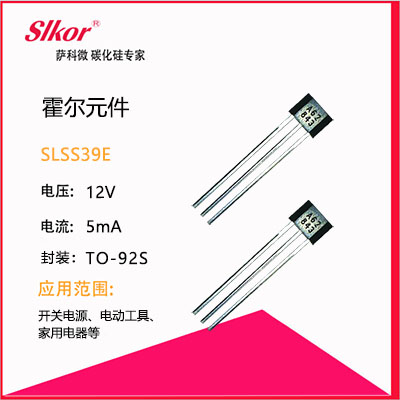Service hotline
+86 0755-83044319
release time:2022-06-13Author source:SlkorBrowse:11970
Hall sensors are used in almost all electronic products we see every day. The following Xiaobian from Sako will share with you the method of judging the potential of Hall elements.

Slkor Hall sensors SLSS39E
The method for judging the potential of the Hall element is:
(1) Measure with the resistance gear of the multimeter. When the voltage is 0, it means that the Hall element is broken;
(2) Connect the two test leads to the power supply and the ground terminal respectively. If the measured resistance value is small, it means that the Hall device is internally short-circuited or open-circuited;
(3) If the measured resistance value is infinite, it is an open circuit.
2. Detection of voltage output Hall switches Hall switches are generally used as current limiting in circuits. Its working principle is to amplify the input signal and send it to the output end, and then control the load current through the control circuit to realize the control of the load. Therefore, to understand its principle and characteristics, it is necessary to master its detection method.
(1) Use the resistance gear of the multimeter to measure whether the voltage drop at the output terminal is zero;
(2) Use the DC working voltage block of the multimeter to check whether there is 220V AC input;
(3) If there is a 220V AC signal input, use an oscilloscope to observe whether there is a sine wave and judge it;
(4) When no 220V AC signal is connected, use a digital frequency meter to test whether the frequency of the pulse signal is between 50HZ and 60HZ
(5) If the above situation does not occur, it can be judged that the performance of the Hall is good
3. Detection of transistor-type Hall Transistor-type Hall switches are often used in electronic circuits. It is a single-phase half-wave rectifier bridge structure composed of two mutually insulated metal sheets to form a semiconductor device with unidirectional conductivity. This component is characterized by small size, light weight, high reliability, and high price. Cheap, etc. But the disadvantages are poor impact resistance, short life and easy damage, etc.
1. The basic working principle of the transistor type is:
A bidirectional full control system consisting of a low-impedance DC negative feedback amplifier and a high-impedance positive feedback amplifier is obtained by injecting forward bias current into the cathode direction through the emitter after adding a reverse bias voltage to the base of a triode. Rectifier. Using this rectifier, a controllable high-precision oscillation loop can be generated for the modulated signal to achieve the purpose of precise control and adjustment of the modulated quantity.
2. Use the characteristic curve of the transistor to determine the fault point
(1) Connect two diodes in series as a reference potential point. Then use a diode to short-circuit both ends of this reference potential point to know the size and changing trend of the forward resistance R1 of the crystal diode at this time.
2. Equivalent circuit of unit tube with reverse bias
3. Equivalent relationship of unit tube with reverse bias
(2) If it is found that R1 is very large and the change is very slow, it means that the tube has been damaged or blown. At this time, it is necessary to replace it with a new one.









Site Map | 萨科微 | 金航标 | Slkor | Kinghelm
RU | FR | DE | IT | ES | PT | JA | KO | AR | TR | TH | MS | VI | MG | FA | ZH-TW | HR | BG | SD| GD | SN | SM | PS | LB | KY | KU | HAW | CO | AM | UZ | TG | SU | ST | ML | KK | NY | ZU | YO | TE | TA | SO| PA| NE | MN | MI | LA | LO | KM | KN
| JW | IG | HMN | HA | EO | CEB | BS | BN | UR | HT | KA | EU | AZ | HY | YI |MK | IS | BE | CY | GA | SW | SV | AF | FA | TR | TH | MT | HU | GL | ET | NL | DA | CS | FI | EL | HI | NO | PL | RO | CA | TL | IW | LV | ID | LT | SR | SQ | SL | UK
Copyright ©2015-2025 Shenzhen Slkor Micro Semicon Co., Ltd